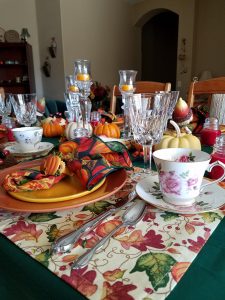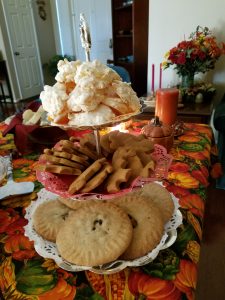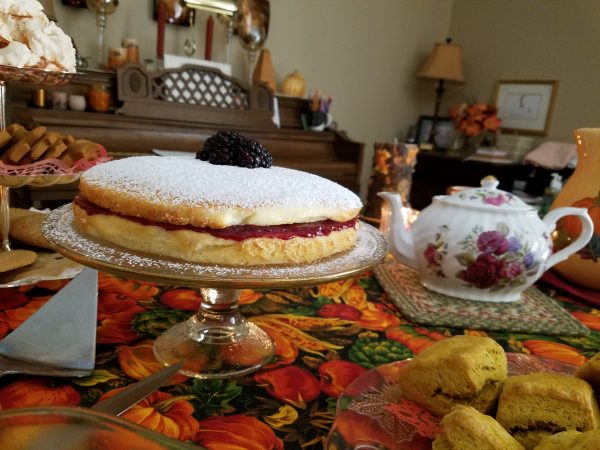Talking About History Over A Cup Of Tea
 Tea, Books, Cookies, and Friends. That combination makes this historian quite happy! Now, that my manuscript on the Battle of New Market is (mostly) complete and the book cover revealed, it’s been time to crawl out of my research cave and relax a little. Some of my girlfriends have been pestering me for details on my writing project and wanted to have a gathering to “talk about history.” Who can say no to that opportunity?
Tea, Books, Cookies, and Friends. That combination makes this historian quite happy! Now, that my manuscript on the Battle of New Market is (mostly) complete and the book cover revealed, it’s been time to crawl out of my research cave and relax a little. Some of my girlfriends have been pestering me for details on my writing project and wanted to have a gathering to “talk about history.” Who can say no to that opportunity?
All of these ladies love tea and good food. So, we dreamed up the idea of tea party. An autumn tea. A historic tea. We combed through the recipe book that I had bought at New Market Battlefield that actually had transcriptions and culinary translations of original recipes treasured and made by the Bushong Family who had survived the battle that unfolded on their property. I was excited to try these historic recipes and anticipated the nice evening tea, but I was in for surprises as the event unfolded. My friends had invited me to give an informal presentation and share “tea appropriate” stories from New Market, but my teaching became yet another learning moment.
Our menu consisted of:
- Chicken Salad (historic recipe)
- Autumn Apple Salad
- Homemade Bread
- Pumpkin Scones
- Blackberries
- Layered Sponge Cake (historic recipe)
- Coconut Cookies, like meringues (historic recipe)
- Gingerbread Cookies (historic recipe)
- Sugar Cookies with Raisins (historic recipe)
- Tea!
Preparing and baking the historic recipes was delightful, and all the ladies learned something along the way. For example… We are very thankful for electric mixers. Spices in old recipes are blended in a way that they become “spicer” a day or two after the cookies are baked. Substituting shortening for lard produces a different type of cookie, but it still tastes fine. There’s a way to make an all-protein mixture from cooked egg yolks to hold chicken salad “together” – no mayonnaise in the 19th Century meant we learned a healthier substitute.
After the tables were set, we waited for the other guests to arrive, paging through other books of historic recipes and even finding some new culinary adventures to try at our monthly girls’ gatherings.

The food was amazing! Sometimes historic foods can be “eh” or “quick, let’s just make a peanut butter sandwich” but these recipes hit the culinary target. They certainly had the taste of 19th Century cooking (and if you’ve done enough historic cooking experiments, you know what that means), but were tasty and filling.
After tea and conversation, we decided to play some games. I had been elected to bring party games that had a Civil War era theme or background. We started off with a memory game; a tray of Civil War related items had been prepared and everyone had 45 seconds to study the display and then 2 minutes to write everything they could remember. Then we talked about the different items and what they represented. Next came “beans and buttons” (a party classic at the Bierle house). It’s simple and old-fashioned: pick through a container of dry beans and pull out the flat, smooth buttons while blindfolded, which is harder and funnier than you might think. Our final game evoked the parlor games and word games from the Civil War era and how people used conversation and story telling for entertainment. We had random autumn or Civil War related words written on paper slips, and we told a story around the table with each person making up a part of the story and using the word on their slip of paper. It was quite a tale, and everyone got the giggles by the end!
Over dessert, I shared stories from New Market’s history and put large printed photos on a display easel for a “battlefield tour” without leaving the tea table. We talked about the Virginia Military Institute Cadets, Generals Breckinridge and Sigel, Miss Clinedinst, Mrs. Rupert, and Captain Preston. Happily, I did not make anyone cry with the carefully chosen stories, and I did not bore anyone to sleep! Since the presentation was informal, my friends interrupted with questions for more and more details, which is a researcher’s delight.
The history started inspiring my friends, and led to an in-depth discussion on character, youth leadership, patriotism, and other ground-shaking topics. They shared from their experiences and observations in the 21st Century, and we compared the lessons and examples of the past.
The food was good, but my favorite part of the evening was when I got to listen. The big ideas brought to the table and reflected from the shared history thrilled me. This is the way history is supposed to work and inspire. We had talked about real history – not agenda-twisted stories. And that real history had prompted all of us to re-examine how we were approaching life, leadership, and influence in our own lives. All of the women at the table that evening are different ages and come from different backgrounds and life experiences. Single, married, separated. Some do contract work. Others own their own businesses. Others teach and perform in the arts community. Some have been to college. Others daily overcome special needs or medical challenges. From those different backgrounds and viewpoints, we looked to the past and then at the present to start asking big questions and daring each other to keep “marching” forward in life.

The candles in the autumn centerpiece flickered. I took another bite of the famous sponge cake made from a recipe originally used by Mrs. Bushong of New Market. I answered history questions. I listened. I thought again how in the moments I least expect it I find the new questions I want to answer about the past to better understand the present.
My girlfriends had invented the idea “let’s have a tea party and you can tell us about your research” and I thought I would “teach” them something. Yet, as I look back on the wonderful evening, I see that the old recipes, the games, and the tea itself became just a gateway to an evening of discussion as we grappled with the ideas from 155 years ago and how they affect our world today. For me, this evening was another memorable reminder that dialog – not endless hours alone or speaking from a podium – is a powerful and effective way to teach and learn. I’m grateful to learn that lesson again.

We are very much looking forward to moving to the Staunton area within 2 weeks. If you decide ebb to have another tea please consider me as part of the cleanup crew. Listening to your conversation and perhaps enjoying a cookie or 2 would be a delight!
Thank you Sarah for your beautiful tour of deserts and teas. I’m looking forward to a sequel coffee and donuts tour. ?
From which Civil War Recipe book did you select the historical recipes?